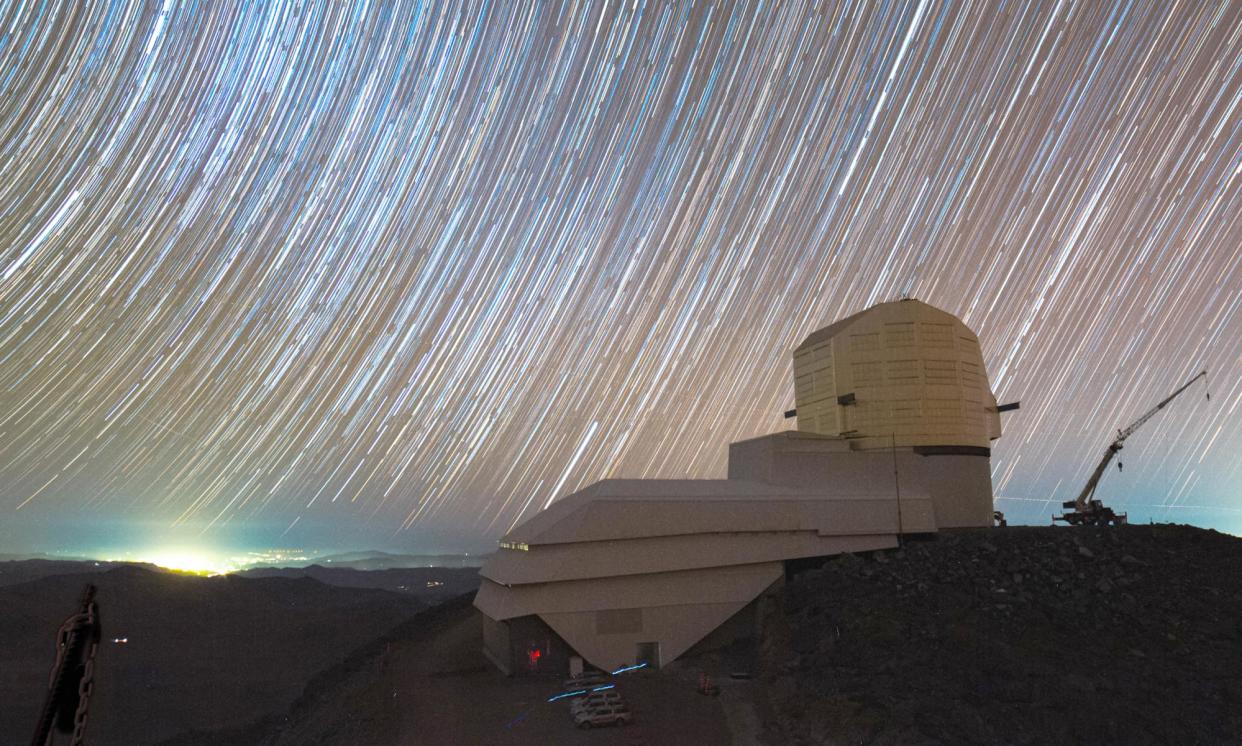State-of-the-art telescope in Chile to offer best view yet of universe

After nine years of construction, a state-of-the-art telescope connected to the world’s largest camera is set to change our understanding of astronomy.
Perched on top of a barren mountaintop in the arid Chilean desert region of Coquimbo, the Vera C Rubin Observatory looks out of this world, quite literally.
Related: Cielo review – love letter to the desert’s starry skies
With a slick, futuristic frame lodged into the mountain’s groove on Cerro Pachón, the observatory is characterised by a distinctively compact, revolving dome-like shape that splinters into a myriad of angles.
The unusual, isolated structure is the heart of a $1.9bn project that will begin to map the sky in early 2025.
“It’s a very special telescope, different from others because it will take a survey of the night sky. It will move a lot,” said Jacques Sebag, the site’s assembly integration and verification manager.
Using a laser pointer, Sebag points out the width of the telescope’s 8.4-metre diameter mirror, fitted with a state-of-the-art 3,200-megapixel camera.
It is designed to capture an unprecedented amount of astronomical data in a 10-year survey called the LSST (Legacy Survey of Space and Time).
“Before this, telescopes saw small areas of the space, looking at very specific information for a very specific problem, but this is like a lighthouse,” he said, his hands spreading out to convey the vast celestial canopy. “It [illuminates] different parts of the sky. It is the fastest-moving telescope ever built.”
The telescope is distinctively squat and compact in design, allowing it to constantly shift and observe changes, registering what astronomers call “the transient sky”.
Every night it will detect 10m events, ranging from asteroid movement to supernova explosions.
“It’s a very rich dataset, it has something for almost everybody in astronomy,” said Frossie Economou, the site’s technical manager for data management.
“We’ll answer questions about the universe from our local neighbourhood – the solar system – to the creation of time, out there in the far reaches.”
Construction of the observatory, which is named after the North American astronomer who proved the existence of dark matter, began in 2015.
The project is principally envisioned to address uncertainties about dark matter and dark energy, which make up more than 70% of the universe.
Chile is home to a number of the world’s most important astronomical centres. The altitude of the Andean mountains that frame the country, and the lack of light pollution in the sparsely populated desert areas, make for ideal skygazing conditions. The Rubin site enjoys an average of 256 clear nights a year.
With the completion of the Rubin project, Chile will become the leading destination of astronomical observation, generating about 70% of data seen from Earth by 2025.
Steve Heathcote is the director of Cerro Tololo, a neighbouring observatory that has conducted studies that serve as a precursor for Rubin.
The telescopes at Cerro Tololo were integral to the discovery of the universe’s accelerated expansion, work that won the Nobel prize for astrophysics in 2011.
Heathcote is hopeful that, once again, Chilean skies will help unlock more of the mysteries surrounding the creation of our universe.
“There’s enough uncertainty in current measurements that you could fit in something different,” he explained, referring to our understanding of the big bang and universe expansion. “I think with Rubin, they’ll be able to get the errors down to the point where you can be sure.
“It could challenge Einstein’s theory of relativity. It could challenge fundamental things in physics.”
Over 10 years, the LSST will generate a staggering 60 petabytes (60,000,000 gigabytes) of data through 2m images. The UK is responsible for processing about 25% of this data.
Aprajita Verma is based at the University of Oxford and is Rubin’s international program coordinator. She refers to the LSST as “the greatest movie of the sky that mankind has ever made”.
“I find it overwhelming. It really will revolutionise our view of survey astronomy and understanding of the billions of objects that we’re gonna see.”
The excitement of the project is rippling through the global astronomical community but is equally felt locally.
Claudia Llanquitruf has been involved in the construction of the site’s revolving dome since 2019.
She manages a company that is usually tasked with mining projects, based in the city of La Serena, about two hours from Rubin.
Llanquitruf is in awe of the site.
“I know what this project means, and all the studies it’s going to generate. It’s an honour to work here.”


